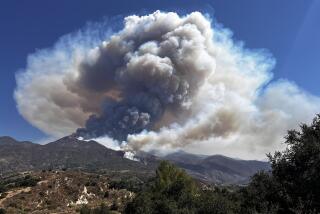When Planned Burns Go Awry
- Share via
MONTAGUE, Calif. — Fires set intentionally to burn undergrowth escape control to become wildfires on federal lands in California far more often than anywhere else.
At least 30 prescribed burns have escaped in the state since 2003, a figure accounting for roughly half of all such fires in the country, according to U.S. Forest Service data analyzed by the Associated Press. Those include two this year that prompted evacuations, highway closures and property losses in Orange and Siskiyou counties.
The Forest Service has apologized for those fires and canceled burns in the Shasta-Trinity and Cleveland national forests as it studies what went wrong.
Prescribed burns are a widely recognized way of lowering the risk of wildfires. In California, an arid climate, strong winds and rugged terrain make those fires much harder to control. And with federal land in California bordering some of the country’s most densely populated suburbs, many planned burns have the potential to displace thousands of people if they escape.
The Forest Service defends planned burning as a necessity in California, where forests choked with undergrowth spawned firestorms in 2003 that killed 22 people and destroyed thousands of homes.
Burns done in carefully controlled situations eliminate the fuels that feed explosive wildfires, said Matt Mathes, spokesman for the Forest Service in California. Controlled fires also are hundreds of dollars cheaper per acre than tree thinning, another way to reduce wildfire risk.
“It’s absolutely critical that we continue a prescribed burning program in California,” Mathes said. “Otherwise, we’re going to see a worsening of a trend that we’re already seeing here. Our fires in California are getting bigger and they’re getting hotter.”
Nationwide, controlled burns on Forest Service land escaped 0.5% of the time from 2003 to 2005. Of the nearly 11,000 fires, fire crews lost control of 54 that burned about 66,000 acres.
In California, the figure was 3%, or 28 fires, for a total of about 21,000 acres.
The two regions that ranked second and third -- the Southeast and Pacific Northwest -- had escape rates of less than 1% despite many more fire starts. Alaska was the only region with no escapes. Experts attribute the lower escape rates elsewhere to cooler weather and higher humidity that make it easier to control the burns.
In February, a controlled burn in Shasta-Trinity National Forest in Northern California, fanned by 70 mph winds, raged out of control, destroying a subdivision home and outbuildings.
Eric Prescott and Phyllis Solomon returned from a monthlong trip to France and Spain to find their custom-built home reduced to ashes, their cars scorched and their dog, Max, dead. Prescott, 56, had a heart attack in his driveway and is now recovering from a quintuple bypass.
The Forest Service has yet to release a formal report on the fire, but Mathes said unusually high winds and human error were to blame. Locals question why anyone would have ordered a fire set in an area where winter winds can reach 100 mph.
Another prescribed fire raged out of control in Orange County in February, burning 10,500 acres, shutting down a highway and forcing the evacuation of more than 2,000 homes. The fire cost $7 million to suppress, according to the final report.
Mathes said prescribed burning was “a critically important program because California is going to burn one way or another. Most prescribed burns happen precisely like they’re supposed to, but every once in a while we do have human error.”
For Prescott and Solomon, that explanation isn’t enough. The couple now live in a one-bedroom apartment in downtown Yreka, Calif. They estimate their loss at more than $500,000 and have hired an attorney to negotiate a settlement with the Forest Service.
More to Read
Sign up for Essential California
The most important California stories and recommendations in your inbox every morning.
You may occasionally receive promotional content from the Los Angeles Times.












